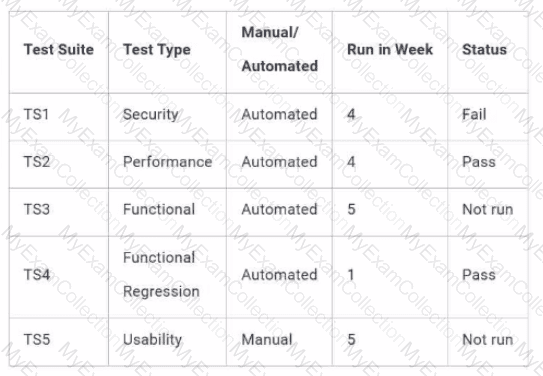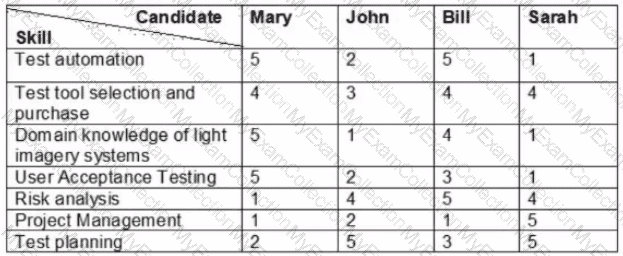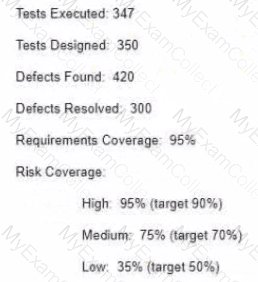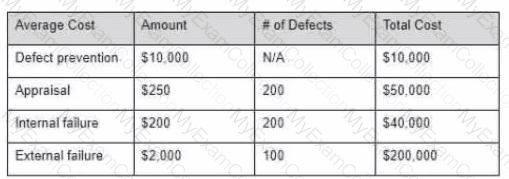You are a test team lead working on a large project and have been subject to considerable stress due to exceptional workload. Your manager has suggested that you need to delegate more work to your team members to both reduce the pressure on yourself and allow team members to take on more responsibility which would, in turn, benefit their growth. Which phase of the Tuckman model would this situational skill represent?
Which one of the following standards would a Test Manager be expected to understand when planning and organising activities with a Project Manager? SELECT ONE OPTION
Which of the following BEST explains how test process improvement can benefit an organisation? SELECT ONE OPTION
You plan to use a heavyweight approach to risk-based testing on a safety-critical system and have the following information available for each documented product risk:
The estimated cost of testing the risk
How likely a failure would arise for the risk item
How much the failure would cost, in terms of lossWhich technique would be MOST suitable?
Which two items are MOST important for inclusion in your tool selection plan for batch-only performance testing?
Which of the following is an advantage of specifying test conditions at a detailed level? [1]
A test team is working long hours to achieve a deadline for release of a new product which has had problems throughout development and is well behind schedule. Which of the following is most likely to have a MOTIVATING effect on the testers in the team?
SELECT ONE OPTION
Which of the following software characteristics are possibly revealed through the application of a open source static analysis tool? [1]
Which of the following are Test Closure activities?
a All results lodged in configuration management system - for example test plans, results, logs, reports.
b. Plans in place for lessons to be learnt to ensure that good practices are repeated and poor practices are not.
c. Checks undertaken to ensure that all test work is completed - all tests executed or skipped, all defects managed to appropriate conclusion.
d. All project closure activities completed - for example customer training completed, and analysis of vendor performance undertaken.
e. AM testing work products delivered to those that need them - for example environments/ regression test sets passed to maintenance.
f. Checks undertaken to ensure that all tests have been executed, with all defects confirmed as fixed by retesting.
SELECT ONE OPTION
Refer to SCENARIO 1
Week 4 of test execution has been completed and the following test report has been produced

Review this report against the organisational Test Strategy, what is the status of the Test Strategy objectives? SELECT ONE OPTION
You are looking to Improve the efficiency of testing. The developers have been claiming that the majority of defect reports they receive are invalid either due to the test environment or because the tester did not follow the right steps In a standard defect management process where should you look for more information about these invalid defects?
You plan to introduce a new tester to your Agile team who has expertise in test automation, a necessary skill lacking in current team members. The individual has a high degree of technical competence but has only ever worked alone and admits to finding face-to-face communication difficult.
What would be the BEST course of action?
Which one of the following will allow phase containment to be assessed within a testing project? SELECT ONE OPTION
Your team has decided that they will build their own test management tool This will allow them to link the requirements and test cases together providing full traceability It will also allow them to create fully customized reporting and color-coded dashboards They have estimated the time required to create the new tool and the cost These fit within the project schedule and budget
What other consideration should be taken before this decision is made?
Which of the following is required to apply an experience-based testing approach''
In what environment are you most likely to see multiple defect management systems used in one project?
If you are monitoring code coverage during testing to determine what areas still need testing what type of testing is likely occurring?
During what step of the Fundamental Test Process should you define the methods to be used to collect test metrics? [1]
Which two of the following are considered to be advantages when specifying detailed test conditions?
a) They may influence development activities.
b) They form the basis for vertical traceability
c) They are suited to agile methodology
d) They can aid defect prevention
e) They are quick and easy to deliver
SELECT ONE OPTION
You have initiated a test process improvement project for your organisation using the STEP model. You have agreed the objectives, goals, scope and coverage of the process improvements with the stakeholders and defined the success criteria that will be applied to the project. Success criteria make risk reduction the most important target benefit for the process improvements, but overall return on investment is also an important consideration. You have just received the initial test
assessment report.
Which ONE of the following would be the next step? SELECT ONE OPTION
Which of the following metrics is MOST LIKELY to trigger a control directive to increase test execution resources?
It is now the last day of the second iteration and the team has been consistently underestimating the time needed. They estimate intuitively rather than using estimation techniques.
Which two estimation techniques would be BEST for the team in this scenario?
You have directed one of your testers to construct a "smoke test" to execute against new builds prior to starting formal testing. This is an example of which software development lifecycle activity?
[1]
You are the Test Manager on a project to replace an old sales and merchandising system with one that will be based on modern platforms.
The main requirements for the system are:
Loading sales data, sent electronically from the stores each evening, into a central database.
Producing sales reports for the merchandisers.
Producing forecast reports, used to predict demand.Loading sales data and producing reports with the current system has frequently taken longer than the overnight processing window allows. The Data Centre Manager requires that all batch processing takes at least 10% less time than currently.The Sales and Merchandising Manager is more concerned about usability because the parameter entry will be complex.Which option contains two key considerations that would need to be added to your test approach?
In relation to cost of quality, which of the following would be classified as a cost of detection? SELECT ONE OPTION
You are preparing the estimate for the test plan, which should cover all test activities subsequent to the plan having been agreed. Estimation of test activities has in the past been embarrassingly inaccurate. Historical data from previous similar projects is unreliable, but for two recent projects it is possible to find out how many test cases were developed and how long this took.
Which TWO of the following estimation techniques will be BEST in this scenario?
You are the Test Manager for a project for a new entertainment booking system using Agile. The project’s objectives include:
Online response time must satisfy customers
Payments must be secure against fraud
In case of system failure, only transactions in progress can be lostWhich option meets all the criteria of the S.M.A.R.T. goal methodology?
You have been promoted to Test Manager within your company. Your new manager states that your test team utilized a risk-based test approach for the last release but in production, a number of
serious failures in lightly tested areas have occurred.
What would be your first action prior to the start of the next test phase for the next release? [3]
Which technique will assist you in determining targeted improvement areas to reduce the number of defects? [1]
You are responsible for porting a performance testing tool to a new operating system. You are at what stage in the tool's lifecycle? [1]
Risks have been identified for a project and they have been analysed using a quantitative method, with the following results for probability and impact.

Which risk should the System Testing focus on mitigating first?
SELECT ONE OPTION
Your team has been assigned to a new project You have a mix of manual testers and automation engineers but everyone is currently doing manual testing. The development learn has alreadydecided to use DevOps as its approach but they have never used it before and are happy to take your input Unfortunately, about 50% of the development is completed already In the testing your team is doing they are finding that about 40% of the defects they catch are actually regressions caused by other changes
Given this information what should you do to help mitigate risk'?
Your organization has decided to augment your testing team with an offshore team. The offshore team members are experienced testers who are experts in the domain of the system under test Your team is worried about the offshore team taking their jobs and they are resistant to the change You need to pick three of your team members to be the ambassadors for the new team
Which competences will be most important for your ambassadors to possess?
Which one of the following options would help ensure success in using an Exploratory Testing approach? SELECT ONE OPTION
'Safe as Houses' is a company that specialises in home security software, including alarm systems, surveillance cameras and other forms of deterrence.
It is currently developing the software for a device which simulates an active television, producing sound and light images that suggest someone is home watching the television. 'Safe as Houses' recently won a lucrative contract to supply the software to Smart Alarms', who will be manufacturing the hardware devices Sound will be created using actual television and film archives, licensed through a third-party supplier, 'Silver Sound Ltd'. A user interface will be developed in house to allow the customer to choose sound tracks.
The software will be delivered as a programme of work, consisting of three projects. Project 1 will develop the software for the light images. Project 2 will develop the sound system and Project 3 will integrate the two using hardware prototypes supplied from 'Smart Alarms'. The programme will conclude with 'Smart Alarms' performing User Acceptance testing in usability labs.
The 'Safe as Houses' test team has experience in testing alarm and surveillance systems but lacks experience in testing light imagery software. The organisational test policy includes the following objectives:
1 Exploratory testing should be used to augment more formal, structured testing within constraints of time and budget
2. Test automation tools should be purchased and employed to maximise the breadth and efficiency of regression testing
The Programme risk register currently includes the following risks:
RISK1 Working prototypes will be delivered late to the integration test environments
RISK 2 A delay in signing the contract with 'Silver Sound Ltd' will impact the programme schedule
RISK 3 Inexperience in testing light imagery software will cause major defects to be missed RISK 4 The user interface software for the sound systems will be delivered late into testing
Refer to SCENARIO 2 - The IT Director for 'Safe as Houses' is recruiting a Programme Test Manager and has been provided with a skills matrix for four prospective candidates. The matrix shows the skill level (5 being highest. 1 lowest) for each candidate:

Consider which of these skills are key for a Programme Test manager in this scenario. Based on these, which candidate would be the most suitable?
SELECT ONE OPTION
Which of the following is likely to occur if reviewers do not have an adequate level of technicalknowledge? [1]
You are monitoring the test results for the first week of system test execution to ensure they conform to the test plan objectives. You are guided by the list of test conditions and traceability matrix produced following test design. Test Plan objectives
• Approach - Risk-based and depth first
• Status reporting - Execution statuses must be either "Passed*, "Failed", "Blocked" or "Not Run"
• Traceability - Test execution results must be traceable back to the test conditions
Test Conditions

Traceability matrix
Which one of the following is a correct statement regarding the current status of test plan objectives?
SELECT ONE OPTION
SoftTech provides a core banking product to retail banks to enable their customers to process payments via the Internet and telephone banking and. as SoftTech's Test Manager, you are responsible for system testing and system integration testing of all SoftTech's products.
Your current project is to integrate SoftTech's core banking product with an existing bank's systems, which are maintained by experienced developers but poorly
documented.
A specification for the 10 interfaces to the bank's existing systems has been produced by SoftTech's development team. There is an estimating matrix for system integration testing that allows 2 man days per interface for preparation, plus 2 man days per interface for test execution. The exit criteria for the completion of system integration testing has been agreed as:
1. No open Severity 1 defects
2 No more than 10 open severity 2 and/or 3 defects
3. All interfaces tested
4. Cost estimate must not be exceeded
System integration test execution is scheduled to last 5 weeks, with week 5 reserved for regression and bug fixing only. At the end of week 3 the following test report has been produced (figures on a week by week basis, not cumulative):

B. Open severity 2 and 3 defects
c. Interface testing progress
d. Development resource for debugging
e. Available budget
SELECT ONE OPTION
The diagram shows a defect workflow in which two states do not have appropriate names.
Which option could correctly provide the missing state names?
You have been asked to make a recommendation on deployment readiness on the software your team has been testing.You have the following metrics:

Given this information what is a critical metric you are missing?
You tend to be conservative in your project estimations because you know how many things can go wrong and extend the schedule. You manager is not happy with your estimates and thinks you are being too negative with your numbers and not trying hard enough Which estimation method should you use to provide your manager with a positive' number while still also providing the number you think is more realistic?
Which of the following Is a way in which risk analysis drives test analysis?
Which of the Mowing should be used to understand the context of testing within an organization?
System testing on your current project is coming to an end and it is time to write the test completion report. The product is an in-house development to support the Sales & Marketing department. Test design was based on requirements analysis.
Which of the following metrics is MOST likely to be useful to help the business stakeholders decide if testing has met its objectives?
Which two of the following activities would normally occur in the Acquisition stage of a tool's lifecycle?
a) Assign a tool administrator to decide on best use of the tool
b) Establish a backup and restore strategy for the tool
c) Review other tools provided by the same vendor
d) Determine how the tool may be impacted by a change to the operating environment
e) Develop and implement a training plan for new users of the tool
SELECT ONE OPTION
At what testing level do the test management activities Include coordinating with end users7
Which of the following best describes the appraisal costs in the cost of quality'
You have been seeing a high number of rejections of defect reports The developers are complaining that they do not understand what the problem is. even though they have been supplied with screenshots. You have checked a number of the 'problem' defect reports and have not found any information that is missing. The descriptions are very detailed and include all the necessary information in a long descriptive paragraph.
What change should you recommend that should help with the developer s problems?
You have been looking at the actual vs expected defects in one high risk area of the software The actual is much higher than the expected value What should you do?
Your team has been assigned to lest a new product that is tightly integrated with existing systems The integrations include data transfers and transformations You have access to the architectural design documents and the integration specifications and some of your testers are former developers.
Given this information, what is the most appropriate test approach?
You are working In an environment that is continually pushing process improvements down to the lest team You are skeptical that any of these have actually accomplished any improvement In fact you know that some of the changes have actually impaired progress
Given this information what step of the IDEAL model is missing?
Your defect opened trend is converging to the closed trend but there is still a gap. What does that gap represent?
Your team has been assigned to test a loyalty card program for a supermarket chain. Because this is a highly competitive market significant investment has been made to determine the shortcomings of the products offered by competitors While the feature sets are mostly the same, there is a wide variance In usability and performance and the users perceptions of these quality characteristics
Given only this information what test approach would be most appropriate?
Which of the following Is considered a heavyweight risk-based testing technique'
You are working on a project that is having problems with regressions. With each release of software given to the test team. 50% of the defects found are actually regressions. To combat this you have decided to implement test automation. You have given your automation team the following goal
'Implement lest automation to automate 90% of the manual regression tests before the product release date.’’
Which of the following is likely an issue with this goal being defined as "SMART?
You are working for an outsource testing company You have a client that will only consider candidates that are highly skilled with Salesforce. regardless of the number of years they have spent testing similar products You have looked through your skills matrix and you have no one with the right type of experience for this project.
What competence area is your team lacking?
You have assembled the following cost of quality numbers 200 defects were found prior to release and 100 were found after.
Given this information what is the total cost of quality for this project?

In an Agile project, when Is it acceptable lo not write a formal defect report when a defect is found''
Which of the following Is the common set of information to be produced in a test estimate''
You have decided to help your team improve their skills. One of their assignments is to mentor a junior member of the team Which competency should you expect the mentor to develop during this exercise?
There is a debate in your organization about who can close a defect report The developers think they should be able to reject and close defects without any further steps The testers are not happy with this approach as they are afraid the rejections may go undetected and the developers may close something without understanding the real problem
How can this problem be rectified7
You are managing the testing for a bank card project. The testing was scheduled to take 10 weeks but by the time the software was developed only six weeks were available for testing Knowing there were a lot of risks with the software your team started testing activities early by overseeing code reviews, defining acceptance criteria by working with the users and by doing all lest creation prior to the code arriving
You are now three days away from the go-live date Your testing has mitigated all the high and medium risk items leaving only the low-risk elements unmitigated by testing You estimate it will take two weeks to manually test the low-risk elements At this point what should you do?

